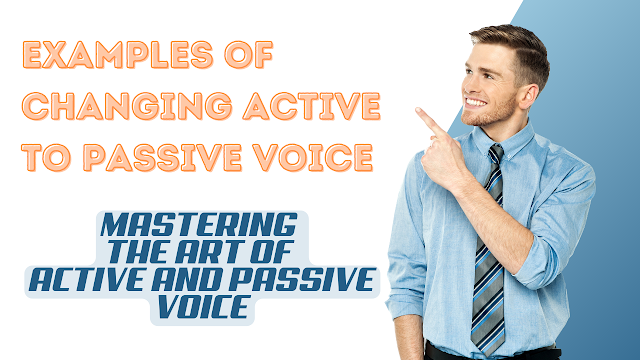Unlocking the Power of Voices in English Grammar
Amplifying the Unheard: Discover the Significance of Voices - An Introduction 🗣️📚

In the vast landscape of English grammar, there exists a concept that adds depth, perspective, and nuance to our language—Voices. Voices, often categorized into Active and Passive, are the lenses through which we view the subjects and objects of our sentences.
In this comprehensive guide, I will take you on a journey to explain the concept of Voices, understand their structure, and explore their diverse applications in the English language.
Table of Contents
Unveiling the World of Voices
- Introduction to Voices
- Active and Passive: The Two Key Players
The Anatomy of Voices
- Active Voice: Subject Does the Action
- Passive Voice: Object Receives the Action
- Voice Conversion: Shifting Perspectives
The Versatility of Active Voice
- Clarity and Directness
- Emphasizing the Doer
- Ideal for Instructions
The Power of Passive Voice
- Shifting Focus to the Receiver
- Anonymity and Objectivity
- Formal and Scientific Writing
Examples of Voices in Action
- Sentences in Active Voice
- Sentences in Passive Voice
- Comparative Analysis
When to Use Active or Passive Voice
- Choosing the Right Voice
- Emphasizing the Subject or Object
Exploring Complex Uses of Voices
- Perfect Passive Voice
- Continuous Passive Voice
- Reporting in Passive Voice
FAQs: Clarifying the Concept of Voices
Conclusion: Mastering the Art of Expression
Unveiling the World of Voices
- Introduction to Voices
- Active and Passive: The Two Key Players
The Anatomy of Voices
- Active Voice: Subject Does the Action
- Passive Voice: Object Receives the Action
- Voice Conversion: Shifting Perspectives
The Versatility of Active Voice
- Clarity and Directness
- Emphasizing the Doer
- Ideal for Instructions
The Power of Passive Voice
- Shifting Focus to the Receiver
- Anonymity and Objectivity
- Formal and Scientific Writing
Examples of Voices in Action
- Sentences in Active Voice
- Sentences in Passive Voice
- Comparative Analysis
When to Use Active or Passive Voice
- Choosing the Right Voice
- Emphasizing the Subject or Object
Exploring Complex Uses of Voices
- Perfect Passive Voice
- Continuous Passive Voice
- Reporting in Passive Voice
FAQs: Clarifying the Concept of Voices
Conclusion: Mastering the Art of Expression
Unveiling the World of Voices
Introduction to Voices
Before we delve into the specifics of Active and Passive Voices, let's understand the fundamental concept of Voices and how they shape our language.
Active and Passive: The Two Key Players
Voices come in two primary forms—Active and Passive. These two voices enable us to express actions and experiences from different perspectives.
The Anatomy of Voices
Active Voice: Subject Does the Action
In the Active Voice, the subject of the sentence performs the action, and the focus is on the doer.
Passive Voice: Object Receives the Action
In the Passive Voice, the object of the action becomes the subject of the sentence, shifting the focus to the receiver of the action.
Voice Conversion: Shifting Perspectives
Learn how to convert sentences between Active and Passive Voices to create distinct tones and emphasize different aspects of the sentence.
The Versatility of Active Voice
Clarity and Directness
Active Voice is known for its clarity and directness in communication. It allows for straightforward, assertive statements.
Emphasizing the Doer
Active Voice shines when you want to emphasize the doer of the action, making it ideal for highlighting responsibility.
Ideal for Instructions
In instructional writing, Active Voice is often the preferred choice, as it provides clear, concise guidance.
The Power of Passive Voice
Shifting Focus to the Receiver
Passive Voice is adept at shifting the focus to the receiver of the action, which can be particularly useful in various contexts.
Anonymity and Objectivity
It allows for a level of anonymity and objectivity, making it suitable for formal, scientific, or impersonal writing.
Formal and Scientific Writing
Passive Voice is a common feature in formal and scientific writing, where the emphasis is on results and actions rather than the doer.
Examples of Voices in Action
Sentences in Active Voice
Explore real-world sentences in Active Voice and understand how this voice is employed to convey actions and ideas.
Sentences in Passive Voice
Dive into sentences in Passive Voice to grasp how this voice shifts the focus and tone of the message.
Comparative Analysis
Compare and contrast examples of Active and Passive Voices to see the impact of using one over the other.
When to Use Active or Passive Voice
Choosing the Right Voice
Discover the factors that influence the choice between Active and Passive Voices, depending on the desired tone and emphasis.
Emphasizing the Subject or Object
Learn how your choice of voice can highlight either the subject or the object, and how this impacts the overall message.
Exploring Complex Uses of Voices
Perfect Passive Voice
Understand how the Perfect Passive Voice adds a layer of time to the action, allowing for precision in describing when something occurred.
Continuous Passive Voice
Explore the Continuous Passive Voice, which conveys actions that are ongoing or repeated.
Reporting in Passive Voice
See how Passive Voice is used in reporting speech or events while maintaining a level of objectivity.
FAQs: Clarifying the Concept of Voices
1. Can the Passive Voice be more concise than the Active Voice?
- In some cases, the Passive Voice can be more concise, especially when the focus is on the action or result rather than the doer.
2. Is one voice inherently better than the other?
- Neither voice is inherently better; the choice depends on the context and the message you want to convey.
3. Can you switch between Active and Passive Voice within the same text?
- Yes, you can switch between voices to add variety and emphasize different aspects of your writing.
4. Is the Passive Voice always more formal than the Active Voice?
- While the Passive Voice is often used in formal writing, it can also be used for clarity and precision in various contexts.
5. How do I recognize the Passive Voice in a sentence?
- Look for sentences where the object of the action becomes the subject and is followed by a form of "to be" and the past participle of the verb.
Conclusion: Mastering the Art of Expression
- Voices in English grammar are more than mere stylistic choices; they are the lenses through which we shape our messages.
- Whether it's the directness of Active Voice or the objectivity of Passive Voice, mastering these voices empowers us to express ideas, actions, and experiences with precision and impact.
- By understanding when and how to use each voice, you become a more versatile and expressive communicator.
- Unlock the power of voices, and you'll find that the way you convey your thoughts can be as diverse and nuanced as the thoughts themselves.
REMEMBER THE KEY POINTS
Voices refers to the arrangements of words according to the requirements.
Sometimes we give more importance to the doer and the other times we give more stress on the action.
When we are speaking one on one to someone we usually raise the level of our voice on the important word of the sentence.






No comments:
Post a Comment